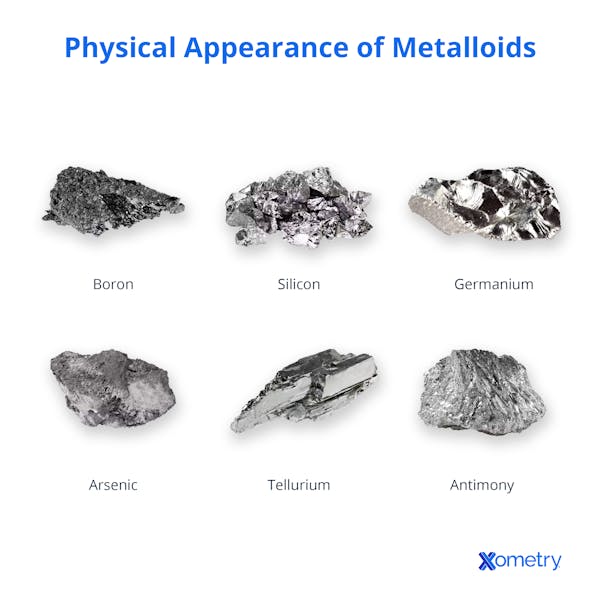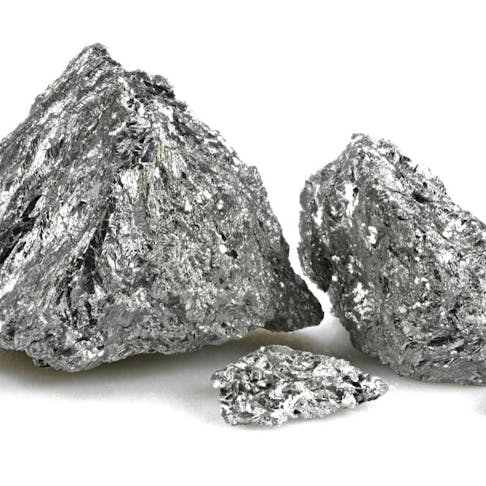Metalloids are a class of elements that have properties of both metals and nonmetals. They fall between metals and nonmetals on the periodic table. The definition of metalloids, as well as the number of elements that fall into the metalloids group, is often argued by scientists. Boron, silicon, germanium, arsenic, tellurium, and antimony are all generally accepted as being metalloid elements, and as such, will be the focus of this article. However, while polonium, astatine, and bismuth are also sometimes classified as metalloids, they will not be discussed.
This article will describe the six most important properties of metalloids and list some key metalloids characteristics.
| Element | Melting Temperature (°C) |
|---|---|
Element Boron | Melting Temperature (°C) 2079 |
Element Silicon | Melting Temperature (°C) 1410 |
Element Germanium | Melting Temperature (°C) 938.3 |
Element Arsenic | Melting Temperature (°C) 817 |
Element Tellurium | Melting Temperature (°C) 449.5 |
Element Antimony | Melting Temperature (°C) 631 |

4. Metalloids Have the Ability To Conduct Electricity, but Not As Well as Metals
Metalloids can be manipulated to behave as either conductors or insulators. This semiconducting behavior is what makes some, if not all, metalloids so useful in controlling complex electronic circuits. Metalloids are modified into semiconductors useful for a wide range of circumstances by a process called "doping." Doping is the process of adding impurities to alter the properties of intrinsic semiconductors, like metalloids. Despite their valuable semiconducting capabilities, metalloids are still poor conductors of electricity compared to metals.
5. Metalloids Behave More Like Nonmetals in That They Easily Form Anions, Have Multiple Oxidation States, and Form Covalent Bonds
The oxidation state of an element refers to the number of electrons an atom either gains or loses to bond chemically with another atom. In the case of metalloids, single covalent bonds are more common. A covalent bond refers to the situation where a pair of atoms share one electron. The oxidation states of the metalloid elements are listed in Table 3 below:
| Elements | Oxidation States |
|---|---|
Elements
| Oxidation States Positive |
Elements Boron | Oxidation States +3, +2, +1 |
Elements Silicon | Oxidation States +4, 0 |
Elements Germanium | Oxidation States +2, +4 |
Elements Arsenic | Oxidation States +3, +5 |
Elements Tellurium | Oxidation States +4, +6 |
Elements Antimony | Oxidation States +3, +5 |
Table Credit: Material-Properties.org
6. Metalloids' Ionization Energies and Electronegativities Are In Between the Values of Metals and Nonmetals
“Ionization energy” refers to the amount of energy that is required to strip an electron from a neutral atom to form an ion. The first ionization energy is the energy required to strip off the first electron - this is the easiest electron to strip. Electronegativity refers to how easily an atom will attract elements when forming a chemical bond. The higher the number, the stronger the attraction. Therefore, the higher the value for electronegativity, the more likely it is that the element will attract electrons. If two elements with similar electronegativities bond, they will form a pure covalent bond that equally shares the electrons. However, if elements have different electronegativities, the resulting molecule will be polarized. This is because the electrons in the bond will be attracted more to the stronger electronegativity element. The metalloids listed in Table 4 below have ionization energies and electronegativities as shown:
| Elements | 1st Ionization Energy (eV) | Electronegativity (Pauling Scale) |
|---|---|---|
Elements Boron | 1st Ionization Energy (eV) 8.298 | Electronegativity (Pauling Scale) 2.04 |
Elements Silicon | 1st Ionization Energy (eV) 8.1517 | Electronegativity (Pauling Scale) 1.9 |
Elements Germanium | 1st Ionization Energy (eV) 7.9 | Electronegativity (Pauling Scale) 2.01 |
Elements Arsenic | 1st Ionization Energy (eV) 9.8152 | Electronegativity (Pauling Scale) 2.18 |
Elements Tellurium | 1st Ionization Energy (eV) 9.0096 | Electronegativity (Pauling Scale) 2.1 |
Elements Antimony | 1st Ionization Energy (eV) 8.64 | Electronegativity (Pauling Scale) 2.05 |
Metalloids’ 1st Ionization Energies and Electronegativities courtesy of Material-Properties.org
Distinguishing Properties of Metalloids
The key distinguishing properties of metalloids are that they have characteristics of both metals and nonmetals. Their ability to act as semiconductors is an important and unique feature of some metalloids. This makes metalloids indispensable in an era when electronic circuits are everywhere.
The elements that are commonly referred to as metalloids are listed in Table 5, along with brief descriptions and a few typical applications:
For more information, see our guide on the Elements of Metalloids.
| Element | Description | Application |
|---|---|---|
Element Boron | Description An allotropic semimetal that is extremely hard and heat resistant. Has an atomic number of 5. | Application Used with silicon to make thermal shock-resistant glass. |
Element Silicon | Description A gray and shiny semiconductive metal. It has high melting (1,410 °C) and boiling points (3,265 °C). Has an atomic number of 14. | Application Commonly used for semiconductors. |
Element Germanium | Description Is hard and brittle in its elemental form. Has an atomic number of 32. | Application Less commonly used for semiconductors. |
Element Arsenic | Description A steel-gray semimetal known for being poisonous. It has an atomic number of 33. | Application Often used as an insecticide. |
Element Tellurium | Description Brittle in its elemental form. It is a chalcogen, along with selenium and sulfur. It has an atomic number of 52. | Application Used as a steel additive to improve machinability. |
Element Antimony | Description A hard, and brittle semimetal with an atomic number of 51. | Application Used to color paints; often alloyed with lead. |
| Properties | Metals | Nonmetals |
|---|---|---|
Properties Electrical Conductivity | Metals Generally conductive | Nonmetals Nonconductive; behave as insulators |
Properties Mechanical Properties | Metals Can be hard or soft, ductile or brittle. | Nonmetals Generally brittle and hard, not suitable for mechanical applications |
Properties Thermal Conductivity | Metals Metals are more thermally conductive than nonmetals | Nonmetals Nonmetals are not very thermally conductive |
Properties Form | Metals Most metals are solids at room temperature (barring a few exceptions like gallium or mercury) | Nonmetals Nonmetals can be in the form of gasses (e.g., hydrogen), liquids (e.g., bromine), or solids (e.g., carbon) |
Ready to Get a Quote?
Take advantage of our network and see what Xometry can do for you.
Summary
Xometry provides a wide range of manufacturing capabilities including 3D printing, CNC machining, laser cutting, and injection molding. Get your instant quote today. Xometry, where big ideas are built.
Disclaimer
The content appearing on this webpage is for informational purposes only. Xometry makes no representation or warranty of any kind, be it expressed or implied, as to the accuracy, completeness, or validity of the information. Any performance parameters, geometric tolerances, specific design features, quality and types of materials, or processes should not be inferred to represent what will be delivered by third-party suppliers or manufacturers through Xometry’s network. Buyers seeking quotes for parts are responsible for defining the specific requirements for those parts. Please refer to our terms and conditions for more information.


